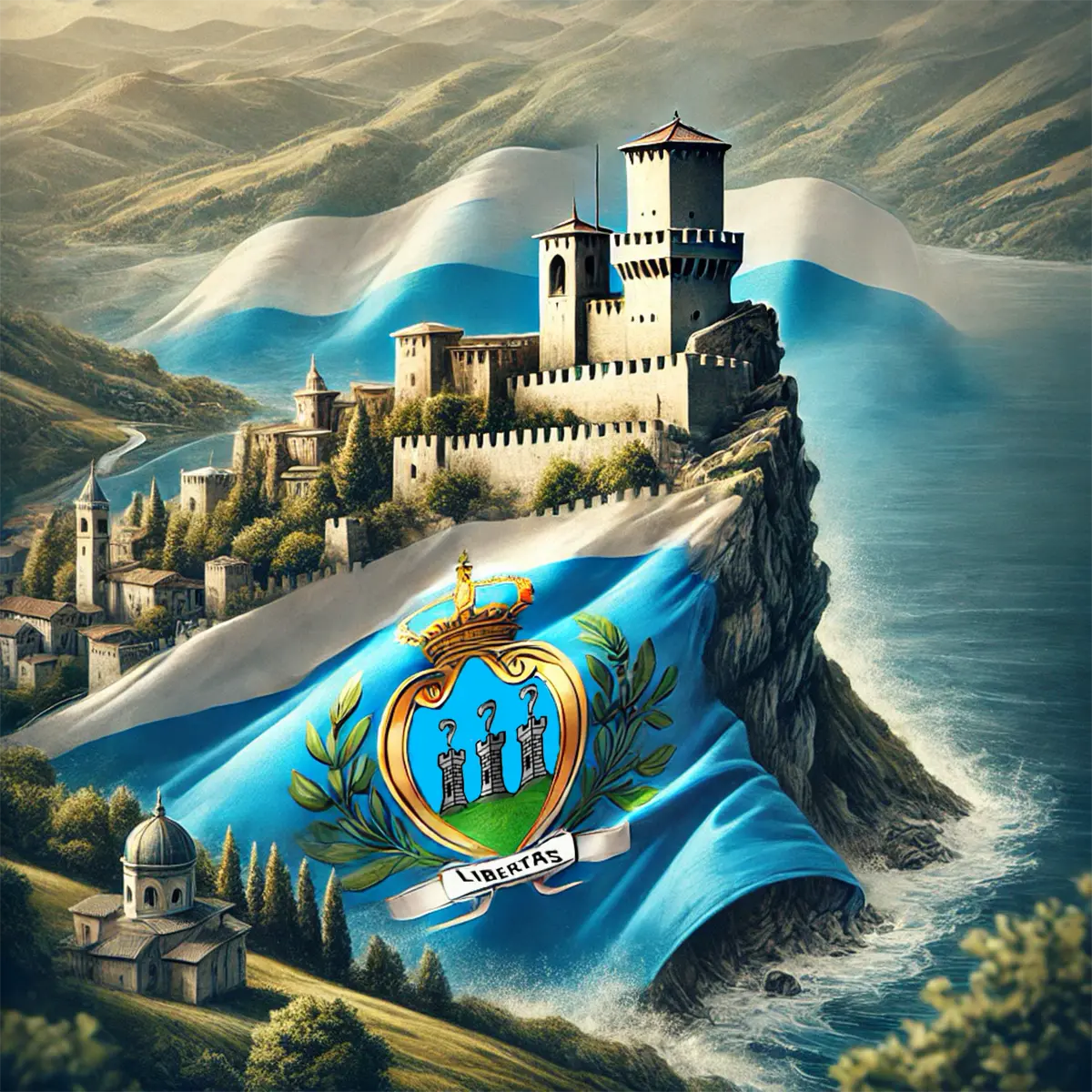The flag of San Marino consists of two colors: white and blue:
- White symbolizes peace and tranquility, which is a particularly important principle for this country. It also reflects the snow of Mount Titano, which is the symbol of San Marino;
- blue represents the sky and freedom, which is in tune with the country's national identity. Its inclusion in the flag reflects San Marino's focus on the principles of freedom, which are enshrined in its motto and inherent in the country's history.
Together, these two colors create a symbolic combination that reflects harmony, peace and freedom.

In addition to the blue and white colors, the flag also features the coat of arms of San Marino, which consists of the following main elements:
- a golden shield
- a golden crown;
- a branch of a laurel tree with fruits Or on the left;
- an oak branch with acorns Or on the right;
- a white ribbon with the country's motto "LIBERTAS".
Each element of the coat of arms has its own meaning:
- The symbolism of the laurel branch has been known since ancient times; the crown of leaves of this tree was used to honor the winners. With the exception of the coat of arms of San Marino, the laurel branch can be seen on the official symbols of France, Brazil, Ethiopia, Mexico, and other countries;
- The branch of the oak, the king of forests, has also been known since time immemorial in the heraldic tradition of Europe and America. The ancient Greeks considered this tree to be the patron saint of Zeus the Thunderer, so its branches, leaves, and acorns serve as symbols of power, strength, and invincibility.
The central place on the coat of arms of San Marino is occupied by a golden shield depicting a blue sky and three white stone towers located on three green peaks.
The towers are of the same shape and size, each decorated with an ostrich feather. They symbolize the country's main historical and cultural landmarks - fortresses:
- Guaita (Italian: Guaita, Prima Torre);
- La Cesta, Fratta, Seconda Torre;
- Montale (Italian: Montale, Terza Torre).
The peaks of Mount Titano, depicted on the shield, are the main geographical landmarks of San Marino. The fortresses, built to protect the borders, are no longer used for their intended purpose, but have become a symbol of San Marino's freedom. Not only were they honored to adorn the country's coat of arms, but they were also minted on local euro coins.
The first tower, Guaita, includes a castle and a church. After the last restoration in 1930, it became accessible to visitors. Since its construction, it has undergone numerous restorations and fortifications that have changed its structure, but never deprived it of its original roughness. The tower has a pentagonal plan and rests directly on the rock of Mount Titano. In the courtyard are several artillery pieces, two mortars and two cannons donated by King Victor Emmanuel II, from which the fortress guards fire blanks on holidays.
The second tower, Fratta or Cesta, includes a castle with a museum of weapons, walls and a small church. It stands on the highest peak of Mount Titano and was used as a watchtower during the Roman Empire. At the beginning of the 14th century, it was equipped with another wall and a series of fortifications that formed the second defensive wall. In 1924, the fortress was restored, saving it from decay and restoring its original appearance. Since 1956, it has been home to the San Marino Museum of Ancient Arms, which displays 700 weapons of various types and periods of manufacture.
The third tower, known as the Montale Tower, is the most modern defense structure. It is the smallest of the three towers and has a tiled roof. Until the 13th century, it was separate from the other two fortresses and was connected to them in 1320 by a wall, traces of which can still be seen today. This tower was of great importance in the battles against the Malatesta family, which owned the neighboring Fiorentino Castle. The bell announced the danger to the population and the arrival of travelers who had to pay a toll. After Malatesta's defeat, Montale was abandoned. Three restorations saved the tower. The tower has a dungeon known as the Fondo della Torre, six meters deep, which can only be accessed from above. It is not accessible to the public.






